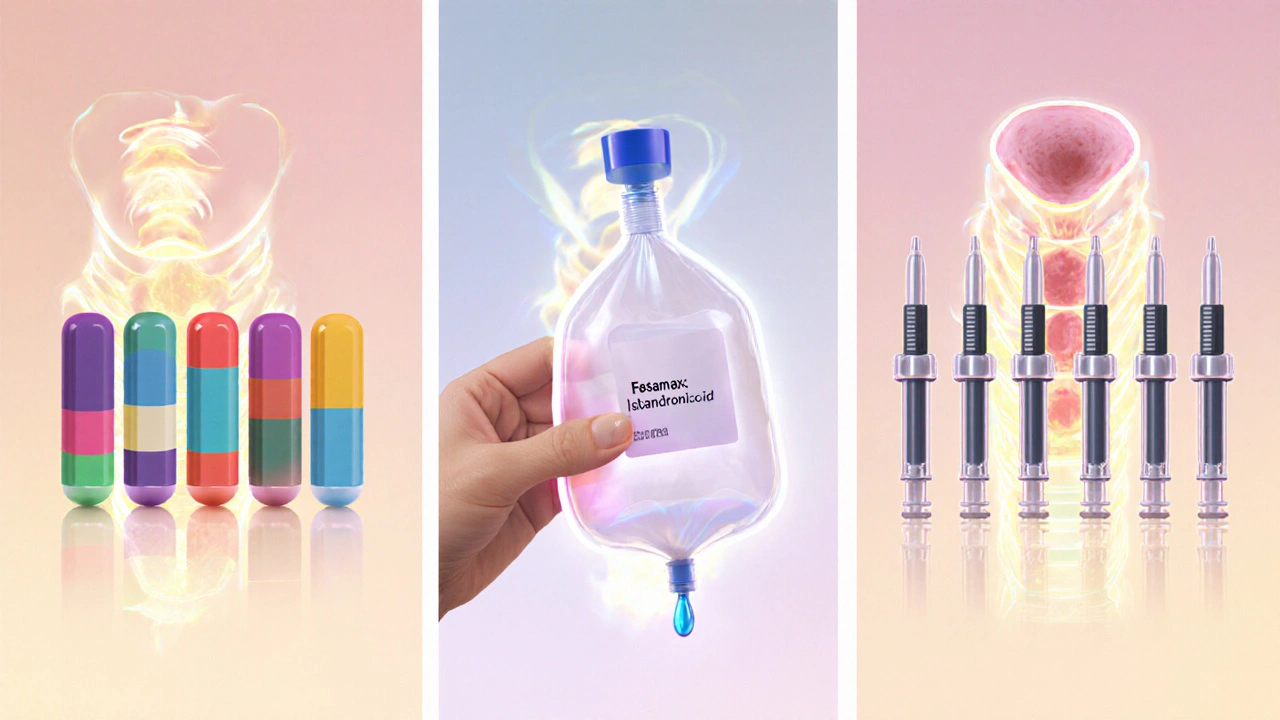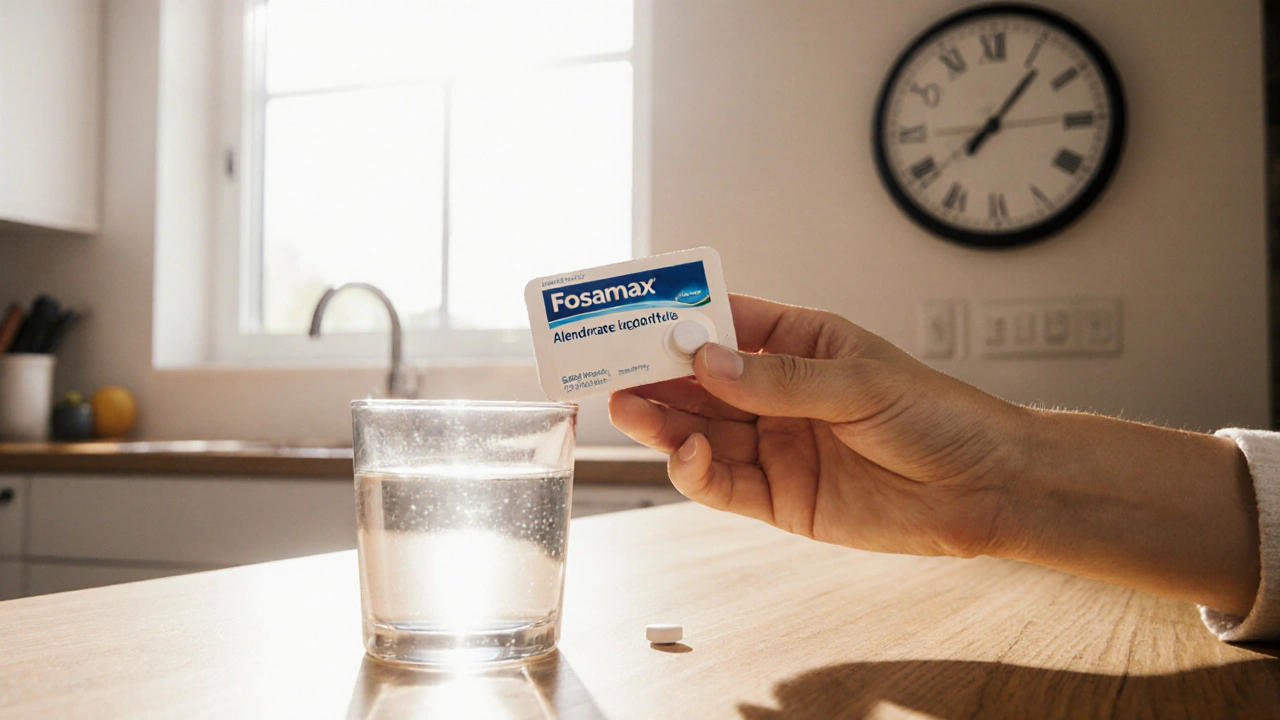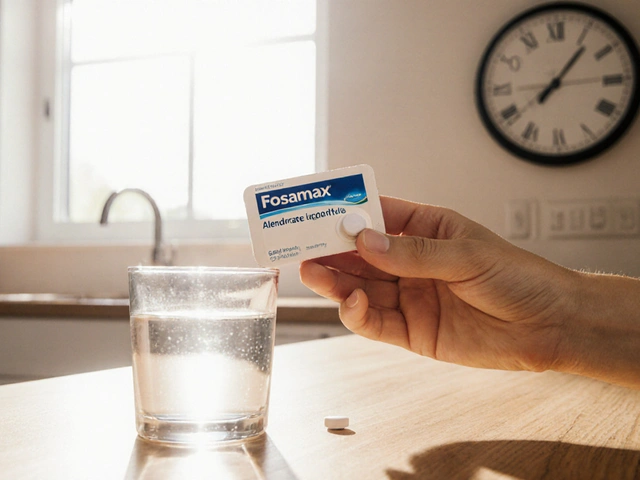Osteoporosis Drug Comparison Tool
Use this tool to compare key features of Fosamax (alendronate) and other osteoporosis medications. Select a drug to see detailed information.
Fosamax (Alendronate)
Weekly oral bisphosphonate
Risedronate (Actonel)
Flexible dosing oral bisphosphonate
Zoledronic Acid (Reclast)
Annual IV bisphosphonate
Denosumab (Prolia)
Subcutaneous monoclonal antibody
Teriparatide (Forteo)
Daily injectable parathyroid hormone
Romosozumab (Evenity)
Monthly monoclonal antibody
When it comes to protecting fragile bones, many people hear the name Fosamax first. But the market is packed with other options that claim to be just as effective, sometimes with fewer side‑effects or simpler dosing. This article breaks down how Fosamax (alendronate) stacks up against its main rivals, helping you decide which regimen fits your lifestyle, health profile, and budget.
Key Takeaways
- Fosamax is a weekly oral bisphosphonate; it’s cheap but can irritate the esophagus.
- Risedronate and ibandronate offer similar bone‑strengthening benefits with different dosing schedules.
- Intravenous bisphosphonates (zoledronic acid) eliminate gut‑related side‑effects but require a clinic visit.
- Denosumab, teriparatide, and romosozumab work via separate pathways and are useful when bisphosphonates fail or are contraindicated.
- Choosing the right drug depends on kidney function, dosing preference, cost, and individual fracture risk.
Fosamax is a brand name for alendronate, a nitrogen‑containing bisphosphonate that slows bone loss by inhibiting osteoclast activity. It received FDA approval in 1995 and has become a first‑line treatment for post‑menopausal osteoporosis and for men with low bone mineral density (BMD). The drug is taken as a 70mg tablet once a week, ideally on an empty stomach with a full glass of water, and patients must remain upright for at least 30minutes to reduce the risk of esophageal irritation.
How Fosamax Works
Alendronate binds to hydroxyapatite crystals in bone. When osteoclasts attempt to resorb bone, the drug is released, disrupting the mevalonate pathway and causing osteoclast apoptosis. The net effect is reduced bone turnover, higher BMD, and fewer fragility fractures. Clinical trials show a 40‑50% reduction in vertebral fractures after three years of therapy.
When Fosamax Is Prescribed
- Post‑menopausal women with a T‑score ≤‑2.5 at the hip or lumbar spine.
- Men over 50 with confirmed low BMD.
- Patients with a history of low‑impact vertebral or hip fracture.
- Individuals intolerant to other oral bisphosphonates that require more frequent dosing.
Kidney function is a key consideration; alendronate is generally avoided in patients with an estimated glomerular filtration rate (eGFR) below 30mL/min because the drug is renally cleared.

Alternatives to Fosamax
Below are the most widely used alternatives, each with a distinct mechanism or delivery method.
Risedronate (brand name Actonel) is another oral bisphosphonate that can be taken daily, weekly, or monthly, offering flexible dosing for patients who struggle with the strict weekly schedule of alendronate.
Ibandronate (Boniva) is an oral bisphosphonate approved for monthly dosing; it’s less potent than alendronate for hip fracture prevention but works well for vertebral fracture risk.
Zoledronic acid (Reclast) is an intravenous bisphosphonate administered once a year, eliminating gastrointestinal side‑effects and improving adherence for patients who forget weekly pills.
Denosumab (Prolia) is a monoclonal antibody given subcutaneously every six months; it works by inhibiting RANK‑L, a key signal for osteoclast formation, and is effective in patients with renal impairment.
Teriparatide (Forteo) is a recombinant form of parathyroid hormone given daily via injection; it stimulates new bone formation rather than just inhibiting resorption, making it ideal for severe osteoporosis.
Romosozumab (Evenity) is a newer monoclonal antibody that both blocks sclerostin (increasing bone formation) and reduces resorption, administered monthly for up to 12 months.
Side‑Effect Profiles at a Glance
| Drug | Route & Frequency | Common Side‑Effects | Renal Considerations | Approx. Annual Cost (AU$) |
|---|---|---|---|---|
| Fosamax (Alendronate) | Oral tablet, weekly | Esophageal irritation, atypical femur fracture (rare) | Contraindicated if eGFR <30mL/min | ~$150 |
| Risedronate | Oral tablet, daily/weekly/monthly | GI upset, acute-phase reaction (flu‑like) | Same as alendronate | ~$200 |
| Ibandronate | Oral tablet, monthly | Stomach discomfort, headache | Similar renal limits | ~$250 |
| Zoledronic acid | IV infusion, once yearly | Acute‑phase reaction, renal function spikes | Monitor creatinine; avoid if eGFR <35mL/min | ~$600 |
| Denosumab | Subcutaneous injection, every 6 months | Hypocalcemia, skin infection at injection site | Safe in moderate renal impairment; caution in severe CKD | ~$1,200 |
| Teriparatide | Subcutaneous injection, daily | Nausea, dizziness, hypercalcemia | No renal dose adjustment needed | ~$4,500 (12‑month course) |
| Romosozumab | Subcutaneous injection, monthly | Injection site reaction, mild flu‑like symptoms | Limited data in severe CKD; monitor calcium | ~$5,200 (12‑month course) |
Pros and Cons of Each Option
Fosamax (Alendronate)
- Pros: Low cost, proven long‑term efficacy, convenient weekly dosing.
- Cons: Must follow strict administration rules, risk of esophageal irritation, not suitable for severe renal impairment.
Risedronate
- Pros: Flexible dosing schedules (daily to monthly), similar efficacy.
- Cons: Still an oral bisphosphonate; GI side‑effects persist.
Ibandronate
- Pros: Only one pill per month, easier adherence.
- Cons: Slightly weaker at preventing hip fractures.
Zoledronic acid
- Pros: Annual infusion eliminates daily pill burden; no stomach irritation.
- Cons: Requires IV clinic visit, higher upfront cost, renal monitoring needed.
Denosumab
- Pros: Works in patients with impaired kidneys; fast onset of BMD gain.
- Cons: Expensive, must not be missed-gap >8 weeks can cause rebound bone loss.
Teriparatide
- Pros: Stimulates new bone formation; best for severe osteoporosis or multiple fractures.
- Cons: Daily injections, high cost, limited to 24months of use.
Romosozumab
- Pros: Dual action (increase formation, decrease resorption); rapid BMD improvement.
- Cons: Very costly, limited long‑term safety data, contraindicated in patients with recent cardiovascular events.
Decision‑Making Checklist
- Kidney function: eGFR<30mL/min → avoid oral bisphosphonates; consider denosumab or teriparatide.
- Adherence style: If you forget weekly pills, look at monthly oral options or yearly IV infusion.
- Cost sensitivity: Fosamax and generic alendronate are the cheapest; insurance coverage may shift the balance.
- Fracture pattern: Hip‑dominant risk → choose a drug with proven hip protection (alendronate, zoledronic acid, denosumab).
- Side‑effect tolerance: If you have GERD, avoid oral bisphosphonates; opt for IV or injection agents.
Common Pitfalls and How to Avoid Them
- Taking the tablet with food or lying down too soon can trigger esophageal ulcers - always follow the 30‑minute upright rule.
- Missing a denosumab dose by more than eight weeks can cause a rapid drop in BMD - set calendar reminders.
- Stopping therapy abruptly without a switch may increase fracture risk - discuss a transition plan with your prescriber.
- Ignoring calcium and vitamin D supplementation reduces the effectiveness of any osteoporosis drug - aim for 1,000-1,200mg calcium and 800-1,000IU vitamin D daily.
Next Steps for Patients and Clinicians
1. Schedule a bone density scan (DXA) if you haven’t had one in the past two years.
2. Review your renal labs and calcium/vitamin D levels.
3. Use this checklist to shortlist 1‑2 candidates that match your medical profile.
4. Discuss insurance coverage and out‑of‑pocket costs with your pharmacist.
5. Initiate the chosen therapy with clear instructions on dosing and follow‑up DXA at 12‑month intervals.
Frequently Asked Questions
Can I switch from Fosamax to another bisphosphonate without a washout period?
Yes, most clinicians allow a direct switch as long as you maintain the same dosing schedule (e.g., weekly to weekly). However, if you move to a drug with a different frequency, a short “drug‑free” window (usually 48‑72hours) helps minimize gastrointestinal irritation.
Is denosumab safe for someone on dialysis?
Denosumab does not require renal dose adjustment, making it a common choice for dialysis patients. Monitor calcium closely, as hypocalcemia can be more pronounced in this group.
Why do some patients experience flu‑like symptoms after zoledronic acid?
The infusion triggers an acute‑phase reaction caused by cytokine release. Symptoms usually resolve within 48hours and can be mitigated with acetaminophen taken before the visit.
How long can I stay on Fosamax?
Guidelines suggest a “drug holiday” after 5‑7years if BMD has improved and fracture risk is low. Your doctor will reassess with a repeat DXA scan before deciding.
Do I need calcium supplements when taking alendronate?
Yes. Adequate calcium and vitamin D are essential for bisphosphonates to work effectively. Aim for the daily recommended intake and take supplements at a different time of day from the tablet.




Nick Ham
October 10, 2025 at 22:48Fosamax’s weekly bisphosphonate regimen yields a 40‑50% vertebral fracture reduction via osteoclast apoptosis inhibition.
Gloria Reyes Najera
October 19, 2025 at 06:48America’s health system finally embraces bisphosphonates, but u gotta swallow that pill right after waking to avoid esophageal burn and keep the bone bank strong.
Abhimanyu Singh Rathore
October 27, 2025 at 14:48Indeed, alendronate requires strict administration guidelines: the tablet must be taken with a full glass of water, patients should remain upright for at least thirty minutes, and the medication should be taken on an empty stomach. Moreover, renal function must be assessed prior to initiation, as eGFR below thirty milliliters per minute contraindicates use. Proper adherence dramatically reduces vertebral fracture risk.
Stephen Lewis
November 4, 2025 at 22:48Dear community, when selecting an osteoporosis therapy, it is prudent to weigh efficacy, safety, renal considerations, and patient preference in a balanced manner. A collaborative discussion with a healthcare professional ensures that the chosen regimen aligns with individual clinical circumstances.
Lynn Kline
November 13, 2025 at 06:48Absolutely! 🌟 Your point about shared decision‑making is spot on; let’s also remember that lifestyle measures-adequate calcium, vitamin D, and weight‑bearing activity-are the colorful threads that weave the strongest bone tapestry.
janvi patel
November 21, 2025 at 14:48Actually, the cheaper oral options aren't always the best choice.
Rin Jan
November 29, 2025 at 22:48The truth about bone health is that no shortcut will replace disciplined lifestyle choices.
You cannot rely solely on a pill to hold up a skeleton that you have neglected for years.
Nutrition, weight‑bearing exercise, and consistent medical supervision form the true tripod of prevention.
When doctors prescribe Fosamax they are doing so within a framework of careful risk assessment.
Ignoring kidney function or swallowing the tablet incorrectly can turn a beneficial drug into a hazard.
Patients who skip the thirty‑minute upright period often suffer esophageal irritation.
The rare atypical femur fracture is a reminder that even powerful agents have limits.
It is morally incumbent on us to follow instructions to the letter.
The healthcare system invests heavily in research to bring us these options, and we owe it to them to use them responsibly.
Cost should never be an excuse to abandon therapy if alternatives exist, but financial strain can be a real barrier.
In such cases, discuss generic options or assistance programs with your physician.
Do not self‑diagnose or self‑adjust dosing because the consequences can be severe.
Remember that injectable alternatives like denosumab or romosozumab also demand strict scheduling.
The overarching goal is to keep fractures at bay, not just to tick a medication box.
Your future self will thank you for the disciplined choices you make today.
Let us all commit to the full regimen, respect the science, and protect our bones with diligence.
Jessica Taranto
December 8, 2025 at 06:48Thank you for such a thorough exposition!; indeed, adherence to proper administration techniques cannot be overstated, and your moral framing adds a valuable perspective.; I would also highlight that patient education materials-often overlooked-play a crucial role in reinforcing those guidelines.